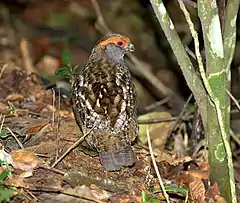| Odontophorus[1] | |||
| Vieillot, 1816[2] | |||
 Przedstawiciel rodzaju – przepiór brazylijski (O. capueira) | |||
| Systematyka | |||
| Domena | |||
|---|---|---|---|
| Królestwo | |||
| Typ | |||
| Podtyp | |||
| Gromada | |||
| Podgromada | |||
| Infragromada | |||
| Rząd | |||
| Rodzina | |||
| Podrodzina | |||
| Rodzaj |
Odontophorus | ||
| Typ nomenklatoryczny | |||
|
Tetrao gujanensis J.F. Gmelin, 1789 | |||
| Synonimy | |||
|
| |||
| Gatunki | |||
| |||
Odontophorus – rodzaj ptaków z podrodziny przepiórów (Odontophorinae) w rodzinie przepiórowatych (Odontophoridae).
Zasięg występowania
Morfologia
Długość ciała 22–30 cm; masa ciała 220–457 g (samce są większe i cięższe od samic)[7].
Systematyka
Etymologia
- Odontophorus (Dentophorus, Odonthophorus): gr. οδοντοφορος (odontophoros) „mieć, nosić zęby”, od οδους odous, οδοντος odontos „ząb”; φερω pherō „nosić”[8].
- Strophiortyx: gr. στροφιον strophion „przepaska na piersi”, od zdrobnienia στροφος strophos „pas, przepaska”, od στρεφω strephō „skręcać, przekręcać”; ορτυξ ortux, ορτυγος ortugos „przepiórka”[9]. Gatunek typowy: Odontophorus columbianus Gould, 1850.
Podział systematyczny
Do rodzaju należą następujące gatunki[10]:
- Odontophorus guttatus (Gould, 1838) – przepiór brązowy
- Odontophorus melanotis Salvin, 1865 – przepiór czarnobrody
- Odontophorus erythrops Gould, 1859 – przepiór obrożny
- Odontophorus gujanensis (J.F. Gmelin, 1789) – przepiór marmurkowy
- Odontophorus stellatus (Gould, 1843) – przepiór rdzawobrzuchy
- Odontophorus capueira (von Spix, 1825) – przepiór brazylijski
- Odontophorus atrifrons J.A. Allen, 1900 – przepiór czarnolicy
- Odontophorus balliviani Gould, 1846 – przepiór andyjski
- Odontophorus leucolaemus Salvin, 1867 – przepiór białogardły
- Odontophorus dialeucos Wetmore, 1963 – przepiór panamski
- Odontophorus hyperythrus Gould, 1858 – przepiór kasztanowaty
- Odontophorus melanonotus Gould, 1861 – przepiór ciemnogrzbiety
- Odontophorus speciosus von Tschudi, 1843 – przepiór peruwiański
- Odontophorus strophium (Gould, 1844) – przepiór białolicy
- Odontophorus columbianus Gould, 1850 – przepiór wenezuelski
Fragment kladogram obejmujący gatunki z rodzaju Odontophorus[11][12][13][14][15]:
| Odontophorus |
| ||||||||||||||||||||||||||||||||||||||||||||||||||||||||||||||||||||||||
Przypisy
- ↑ Odontophorus, [w:] Integrated Taxonomic Information System (ang.).
- ↑ L.J.P. Vieillot: Analyse d’une nouvelle ornithologie élémentaire. Paris: Deteville, libraire, rue Hautefeuille, 1816, s. 51. (fr.).
- ↑ F. Boie. Bemerkungen über mehrere neue Vogelgattungen. „Isis von Oken”. 21, s. kol. 326, 1828. (niem.).
- ↑ Ch.L. Bonaparte. Prospetto del Listema Generale di Ornitologia. „Giornale Arcadico di Scienze”. 49, s. 54, 1831. (wł.).
- ↑ Ch.L. Bonaparte. Tableaux paralléliques de l’ordre des Gallinacés. „Comptes Rendus Hebdomadaires des Séances de l’Académie des Sciences”. 42, s. 883, 1856. (fr.).
- ↑ F. Gill, D. Donsker & P. Rasmussen (red.): IOC World Bird List (v11.2). [dostęp 2022-01-04]. (ang.).
- ↑ J.P. Carroll: Family Odontophoridae (New World Quails). W: J. del Hoyo, A. Elliott & D.A. Christie: Handbook of the Birds of the World. Cz. 2: New World Vultures to Guineafowl. Barcelona: Lynx Edicions, 1994, s. 428–432. ISBN 84-87334-15-6. (ang.).
- ↑ Odontophorus, [w:] The Key to Scientific Names, J.A. Jobling (red.), [w:] Birds of the World, S.M. Billerman et al. (red.), Cornell Lab of Ornithology, Ithaca [dostęp 2022-01-04] (ang.).
- ↑ Strophiortyx, [w:] The Key to Scientific Names, J.A. Jobling (red.), [w:] Birds of the World, S.M. Billerman et al. (red.), Cornell Lab of Ornithology, Ithaca [dostęp 2022-01-04] (ang.).
- ↑ Systematyka i nazwy polskie za: P. Mielczarek & M. Kuziemko: Podrodzina: Odontophorinae Gould, 1844 - przepióry (wersja: 2022-09-11). [w:] Kompletna lista ptaków świata [on-line]. Instytut Nauk o Środowisku Uniwersytetu Jagiellońskiego. [dostęp 2022-10-10].
- ↑ J. Boyd III: Odontophoridae: New World Quail. [w:] Taxonomy in Flux Checklist 3.08 [on-line]. John Boyd’s Home Page. [dostęp 2022-09-10]. (ang.).
- ↑ T.M. Crowe, R.C.K. Bowie, P. Bloomer, T.G. Mandiwana, T.A.J. Hedderson, E. Randi, S.L. Pereira & J. Wakeling. Phylogenetics, biogeography and classification of, and character evolution in, gamebirds (Aves: Galliformes): effects of character exclusion, data partitioning and missing data. „Cladistics”. 22 (6), s. 495–532, 2006. DOI: 10.1111/j.1096-0031.2006.00120.x. (ang.).
- ↑ T.M. Crowe, P. Bloomer, E. Randi, V. Lucchini, R. Kimball, E. Braun & J.G. Groth. Supra-generic cladistics of landfowl (Order Galliformes). „Acta Zoologica Sinica”. 52 (Supplement), s. S358–S361, 2006. (ang.).
- ↑ C. Cohen, J.L. Wakeling, T.G. Mandiwana-Neudani, E. Sande, C. Dranzoa, T.M. Crowe & R.C.K. Bowie. Phylogenetic affinities of evolutionarily enigmatic African galliforms: the Stone Partridge Ptilopachus petrosus and Nahan's Francolin Francolinus nahani, and support for their sister relationship with New World quails. „Ibis”. 154 (4), s. 768–780, 2012. DOI: 10.1111/j.1474-919X.2012.01269.x. (ang.).
- ↑ P.A. Hosner, E.L. Braun & R.T. Kimball. Land connectivity changes and global cooling shaped the colonization history and diversification of New World quail (Aves: Galliformes: Odontophoridae). „Journal of Biogeography”. 42 (10), s. 1883–1895, 2015. DOI: 10.1111/jbi.12555. (ang.).
This article is issued from Wikipedia. The text is licensed under Creative Commons - Attribution - Sharealike. Additional terms may apply for the media files.